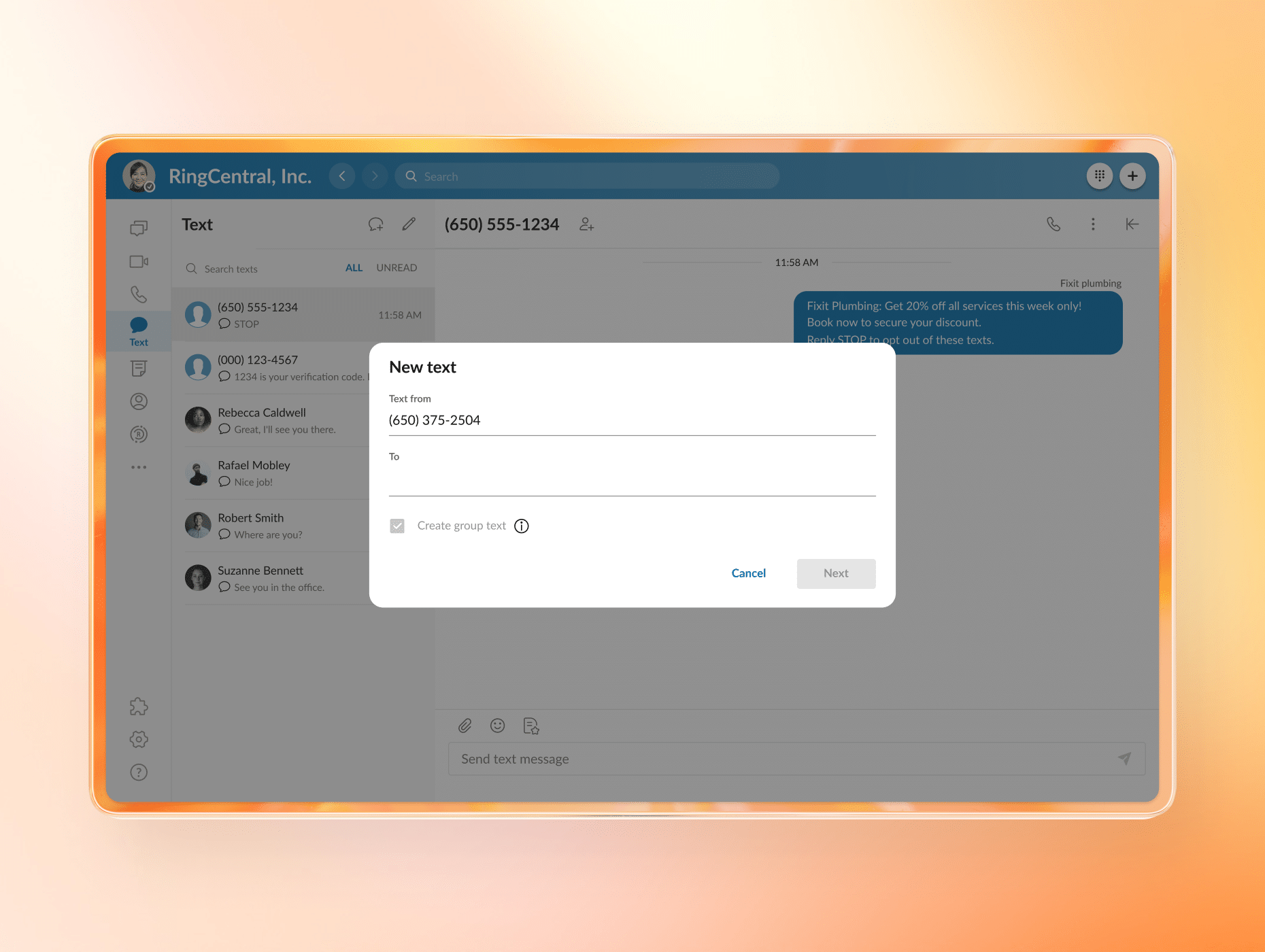When it comes to decision-making, humans often rely on the opinions and perspectives of others. Whether it’s choosing a morning coffee or making a major purchase like a new car, we often seek input from our network to make more informed decisions.
With the Internet, our networks have expanded significantly, allowing us to access opinions from people worldwide with just a quick online search.
Customer reviews play a crucial role in shaping consumers’ decisions, influencing many purchasing choices. There is a huge variety of customer reviews examples too, from simple comments on a company’s Facebook page to in-depth software reviews on G2 and other third party websites.
While reviews naturally accumulate over time, businesses can speed up this process by proactively getting feedback, leveraging positive reviews to attract more customers, and effectively addressing negative feedback to improve their reputation and foster long-term customer relationships.
Keep reading to learn about:
- What a customer review is
- What makes a positive customer review
- Why customer reviews are so important
- How to help your customers write the perfect review
- Popular online review platforms
- 9 customer reviews examples: the different types
- 10 satisfied customer reviews examples
- Positive reviews by industry
- 10 bad customer reviews examples
- How to respond to positive customer reviews and negative customer reviews
- 7 best practices for encouraging clients to leave great customer reviews
What is a customer review?
First things first, let’s define exactly what we mean by a customer review. Reviews are accounts of your product or service, as experienced by your own customers.
They can either be in written format on your own site, a review site, or social media. They may also be video reviews on sites like YouTube. These usually offer a glimpse into how your product works in action, making it even easier for customers to decide whether they want to buy the product in question.
What makes a positive customer review?
A positive customer review is one in which the customer has had an overall positive experience with a product or service provided by a particular company. This type of review usually contains information about why a company and its products or services can be trusted and are recommended.
For example, a positive customer review may indicate that the staff were friendly and efficient and that the product in question is exactly as advertised and is really worth the money.
Why are customer reviews so important?
People are influenced by those around them, whether that’s friends and family, industry experts and influencers, or even internet strangers. This is why customer reviews are so important—they act as social proof.
Social proof can push customers on the fence about buying a product to make a purchase (or consider other alternatives). While there are many forms of social proof (like influencer campaigns and company partnerships), customer reviews have a special place in shoppers’ hearts.
In fact, 99.9% of customers consult reviews when shopping online, and 98% say reviews are an essential resource when making purchase decisions.
Think about the last time you tried a new restaurant. Or bought a vacuum. You probably looked for reviews online first, right? When considering a purchase, people want first-hand perspectives from others like them. While a famous influencer might catch their attention, experiences from peers are also important if you want to convince them to buy.
Genuine customer reviews help to build and boost your brand reputation, attract new customers, and encourage repeat custom. They’re also good for SEO, since search engines use off-site reviews as indicators of brand authority. All of which means an increase in traffic and revenue. In fact, landing pages with customer testimonials can increase conversion rates by up to 34%, highlighting the tangible impact of showcasing customer feedback.
Depending on the industry your business is in, customer reviews might be especially important because they can help offset other factors that might sway a prospect against purchasing your products or services—for example, a more expensive price.
How to help your customers write the perfect review
Now that you know just how important customer reviews can be for your business, let’s find out how you can help your clients craft a meaningful review that’s valuable to both your business and potential customers.
1. Provide a feedback form that goes beyond a star rating
When potential customers want to find out other people’s opinions of a product or service, star ratings can be a quick way of getting an idea of what people think of it. But star ratings alone don’t tell the full story.
Five-star ratings suggest that a product or service is perfect in every way, while one-star reviews suggest the opposite. But what about every rating in between? And what is it about a product or service that’s so bad that it deserves a one-star review?
If the customer feedback form on your website provides the option to leave a star rating, try to encourage customers to leave some written feedback too to explain why they have given something a particular rating.
It’s a good idea to provide prompts to help with this. For example, you could ask questions such as “How could this product or service be improved?” or “What did you like the most about this product or service?”. Or get them to highlight the stand-out features or benefits.
2. Provide the option to add photos or videos of the product or service in use
Providing prospects with a way of seeing your existing customers using your products or service is an excellent way of enticing them to convert.
This provides them with concrete evidence of exactly how well your product or service works. It’s the next best thing to their friend or family member demonstrating it in person.
When people are able to see how well your products and services work for your existing customers, they’ll be more likely to want in on the action. Reviews containing photos or videos are also more likely to grab people’s attention and make them want to share the review on social media and spread the word about your business even further.
3. Ask people how long they’ve been your customer
If applicable to your industry, ask customers to state how long they’ve been a customer with your business. This can make the review appear more trustworthy if someone has been a customer for a long time as it indicates that your company and its products or services have been consistently reliable.
4. Ask if a particular employee stood out
Have you ever used a company and one of their workers sticks in your memory for all the right reasons? Prompting your customers to mention someone like this in their review adds a touch of personality to your brand and humanizes your company.
By creating a genuine connection with prospects in this way, they’ll be more keen to purchase from your business, safe in the knowledge that when they become your customer, there will be staff on hand to help at every turn.
Popular online review platforms
It’s all well and good knowing how to write customer reviews, but it’s important to also place them on online platforms where people will easily find them. So, let’s check out where your reviews would be best situated.
1. Tripadvisor
Seeking a sun-soaked trip in the Mediterranean or a ski trip to Jackson Hole? Head on over to Tripadvisor to discover the best places to play, stay, and rest.
Customer reviews on Tripadvisor usually include photos of hotel rooms, scrumptious meals, and first-hand views of world-famous tourist attractions alongside written reviews of real-life experiences of restaurants.
If you run an eatery or offer accommodation for tourists, having your business reviewed on Tripadvisor is sure to spread the word of what you have to offer.
2. Trustpilot
Trustpilot is an online review platform that promotes trustworthy reviews about a variety of business types. All reviewers on the site are encouraged to verify their identity to help consumers make purchase decisions based on reviews that they know they can trust.
Reviews on the site aren’t vetted and companies are unable to pay to have negative reviews removed, meaning that the feedback you see on the site is an exact representation of consumers’ experience with a particular company.
3. Facebook
The social media giant isn’t just for keeping in touch with family and seeing what your friends got up to at the weekend. It can also be used to write and read reviews of any business that has a Facebook account.
If you’re a small local business, it’s a great marketing idea to ask customers to leave a review on Facebook that lets the people around them know what they thought of your business. In no time, you’ll be seeing their friends and neighbors turn up at your company to see what you have to offer.
4. Google
Everyone’s go-to when they’re on the hunt for… well anything. Not only can you find every product or service under the sun, but you can also leave and peruse reviews to your heart’s content.
5. Capterra
When it comes to review sites for software for businesses, there’s nowhere better to check out than the Capterra site.
So, if you’re a business that sells this type of software, it’s a great marketing tactic to make sure that your offerings are reviewed there as it’s seen as one of the most trustworthy review sites. Facebook reviews just won’t cut it for this type of product.
9 customer review examples: The different types
Customer reviews come in many different forms. Including a few positive customer review examples on your website can improve your chances of winning more customers—who doesn’t want that?
Anything you can do to make it easy for your happy customers to write those reviews for you will help. For example, here’s a handy Mad-Libs-style customer review builder that you can attach to your message or email to the customer when you’re asking if they can write a review or testimonial for you:
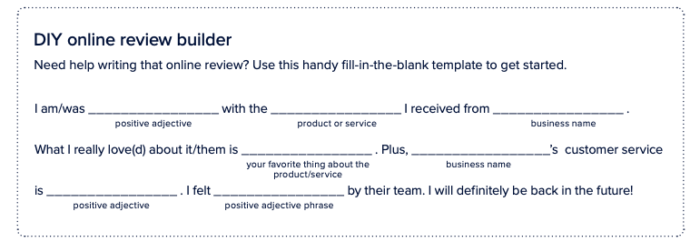

Let’s walk through some great customer reviews examples, starting with the easiest ones to collect.
1. Quotes
Testimonials or quotes from your customers are one of the most common forms of customer reviews. You’re most likely to find them on a company website, typically on the homepage or in their marketing materials.
Here’s an example of a quote testimonial from WordPress:

These short (typically only one to two sentence) overviews of how your product or service impacted a company help give your brand credibility. With quote testimonials, those impressive claims you’re making sound believable because they’re backed up by someone who’s, well, not you.
We list customer quotes as the easiest type of review to get because they involve very little effort for you and your customer. Because you’re in control of adding them to your website, all you need to do is ask your customers to share their experience in an email, in person, or over the phone.
Quotes also allow you to choose the great customer service stories, perspectives, or opinions you think are most valuable. You can highlight your high-profile clients—and who says you have to include the negative customer review examples?
How to get quote reviews:
Ask for it. Call up your long-term customers and ask if they’d be willing to share a testimonial or a bit about their experience working with you to display on your website.
Or look for positive words of encouragement in email and social media responses or everyday conversations. If a customer gives you a great quote, ask if you can showcase it on your website.
You might be on multiple social media platforms, so how can you keep track of all these messages? If you’re providing omnichannel customer service, you might already be using a tool that can consolidate all your customer conversations and communication channels into one handy dashboard. Like this:
To get awesome customer reviews, you must provide awesome customer service. Learn how to provide proactive and agile customer service.
2. Peer review sites
Peer review sites are probably what you think of when you think of customer reviews. These include Google reviews, Facebook reviews, Yelp, Amazon, or G2 Crowd (if you’re a software company).
You’ve probably encountered these kinds of reviews while you were deciding whether or not to try a local business for the first time.
Reviews on peer-to-peer sites can happen organically, often removing the company from the review process entirely. (This can be a nightmare if you’re managing a small business since one bad review can have a huge impact, but this also makes the reviews seem more authentic.)
Customers don’t need to worry about companies editing them to be more favorable (or deleting reviews they didn’t agree with). However, this also means you don’t have as much control over these kinds of reviews.
But that doesn’t mean you can’t do anything at all. These peer-to-peer review sites are often one of the first places a potential customer looks when considering a purchase, so ensuring you have some positive reviews on each is important.
How to get a review on a peer review site:
Again, the best way to do this is to ask. Send an email, ask in person, or add links to your website that make it easy for customers to leave their opinions. Once there are multiple good reviews on a third-party site, you can pull these into your own website and display them as another form of social proof.
3. Social media
Social media is becoming just as much a resource for businesses that want to build brand awareness as it is for people who are interested in connecting with brands. But don’t just use your social media campaigns for sales. Not only are customers turning to social media to ask brands questions or learn about their services, but they’re also using their accounts to share opinions and reviews.
Here’s an example from American Eagle’s spin-off clothing line Aerie:

Like peer-to-peer review sites, the company usually isn’t involved in the review process—making them feel more transparent and honest. One of the biggest benefits of having reviews on social networks, like peer-to-peer review sites, is that your company isn’t involved or seen and there’s less perceived bias (compared to testimonials on your website—a smart customer will know that you picked only positive reviews to showcase on your site).
How to get social media reviews:
Encourage customer reviews on social media by creating communities where customers are empowered to share their experiences or purchases. For example, Aerie uses the hashtag #AerieReal to make it easy to see how customers are styling their items in real life:
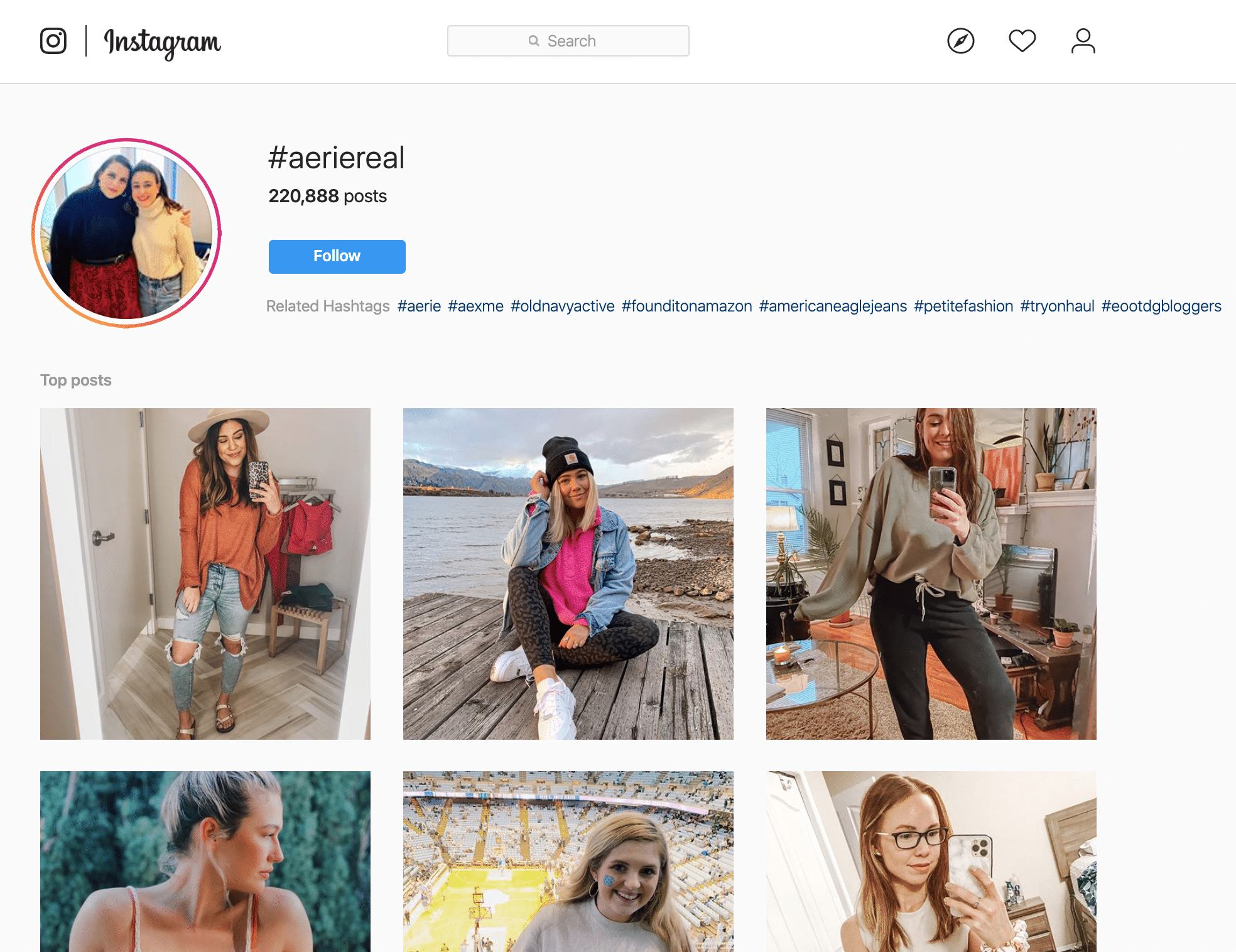
4. Case studies
Case studies dive deep into customer results and are particularly useful for businesses selling to businesses (aka the B2B space).
Here’s an example of a case study of Brightway Insurance:
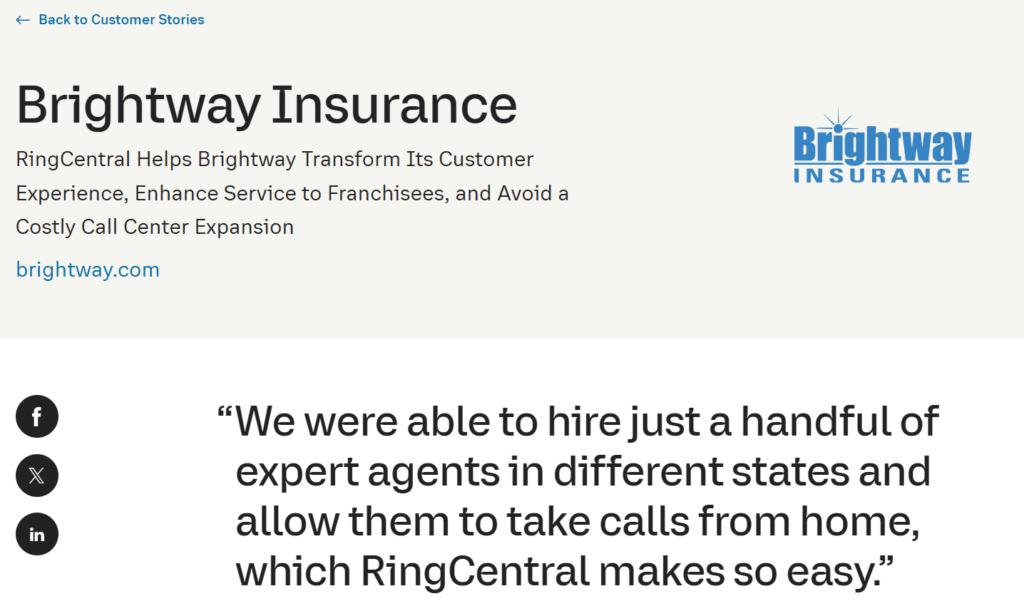
Case studies—unlike traditional customer reviews—are written from the perspective of the company doing the work or providing the product. Rather than the customer explaining how they helped, the company walks through what they did to help their customer reach their goals.
This perspective gives potential customers a different (though admittedly biased) perspective of what your company does, and gives you a chance to highlight your products and services in exactly the way you want them positioned. Unlike other customer reviews examples in this list, case studies give you total control of the story.
How to get case study reviews:
Write your own! Be sure to interview your customers and/or get their permission to share their story first. Mix in quotes, results, and ROI numbers from your customers to back up your claims. Each case study should read like a partnership—not just a one-sided perspective.
5. Customer stories and interviews
Closely related to case studies are customer stories—sometimes they are referred to interchangeably, but customer stories should be less focused on your company, and more on the customer.
Customers want to see themselves in the people your company has already helped—your company shouldn’t be the star in these stories and interviews.
Squarespace is one company that does this well:

Through stories and interviews, Squarespace shares who their customers are, what the vision or mission of their website is, and how Squarespace provides them with the platform to reach those goals.
Squarespace gets an opportunity to showcase how diverse their customer base is, but notice how they position themselves as the Robin to the customer’s Batman. What is the customer is hoping to accomplish? What are their challenges and pain points? What benefits did they see after using your product or service?
How to get customer story-style reviews:
Stories and interviews give a more personal perspective. Instead of hearing from your company, they’re hearing stories from the customer. So, to get those stories, send customers a questionnaire or do an in-person interview.
Allow your customers to share their stories, then focus on filling the rest of the narrative with images, videos, and other content.
💡 Get more happy customer reviews with these free outreach templates (and DIY customer review builder).
6. Blog posts
Blog post reviews give your potential customers an opportunity to dig deep into your product or service and even your brand and culture as a company.
Rather than just a sentence or two like a customer might find on your website or a few hundred words displayed on a peer-to-peer review page, blog posts can be thousands of words, complete with step-by-step instructions with images that thoroughly explain a process or perspective.
This is a great example of a blog post review on Warby Parker:
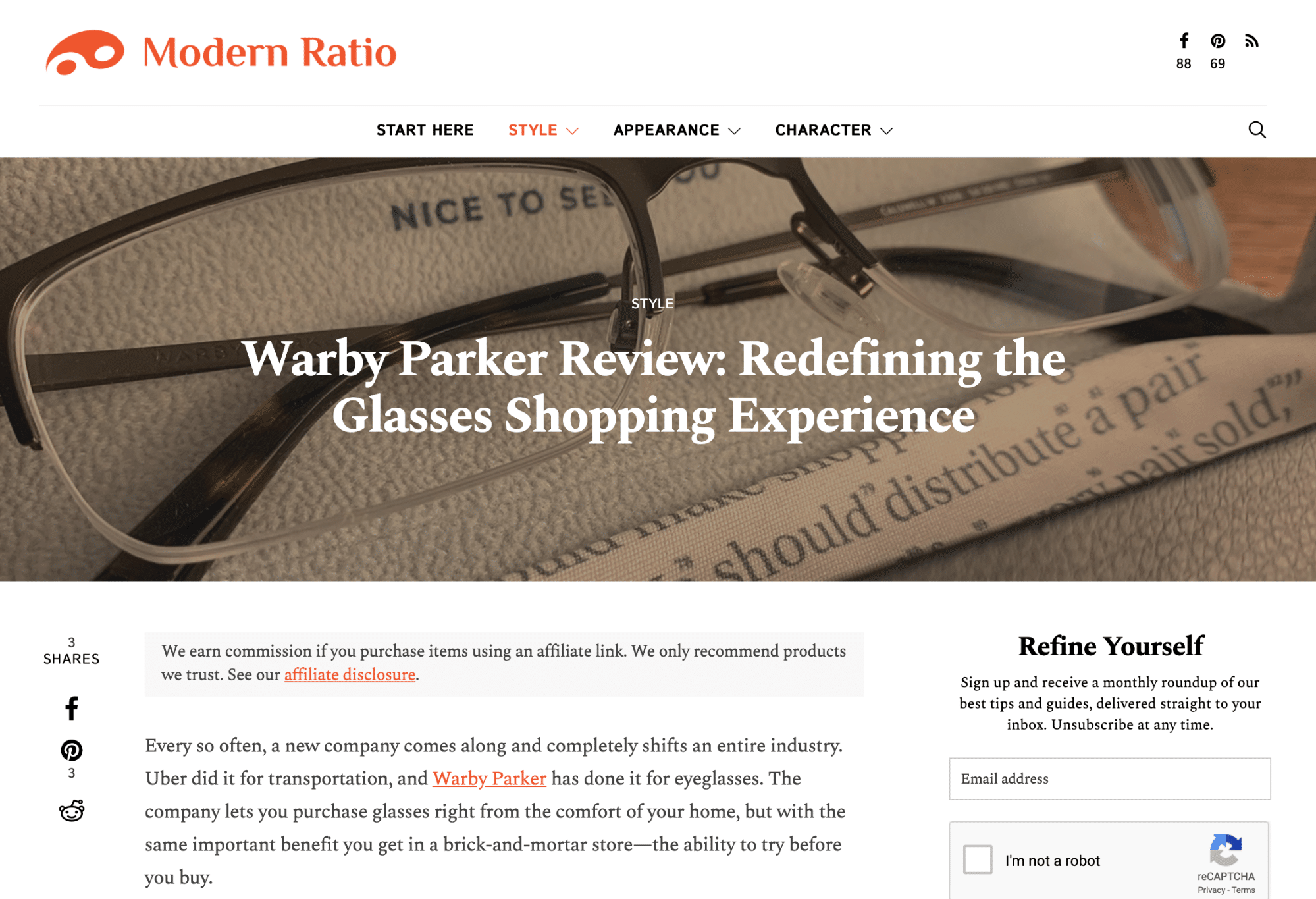
These kinds of reviews can typically answer more complicated questions that require more space and time—something that isn’t possible with traditional reviews.
But one of the biggest benefits of blog post reviews is the SEO value, meaning you can get these pages to show up on Google when people are searching for reviews of your business. If you’ve ever searched for “[product] review,” you’ve probably encountered a post like this before. Because these posts tend to be descriptive, long-form, and useful, they can rank pretty highly.
How to get blog post reviews:
Getting reviews like this one can be a little difficult. After all, not everyone has a blog to write on. You can increase your chances by offering a free sample or trial of your products or other goodies to industry influencers and experts who run popular blogs.
7. Videos
Consumers like videos. This isn’t anything new, so why not take advantage of it?
Shopify is one example of a company using video testimonials:

Video reviews can give potential buyers something most written reviews can’t: a firsthand perspective directly from a peer or competitor about whether your product or service worked well for them—unfiltered and unedited.
Video testimonials are typically basic—recorded from a webcam or phone camera with low production value. And even though aesthetically this isn’t the most polished, it does make the testimonial seem more real, and perhaps more trustworthy. This can be a low-cost and easy type of customer review to leverage to build a stronger connection with your customers and spark more sales.
Creating videos doesn’t need to be complicated. Customers sharing selfie-style videos talking about what your product has done or just stationed in front of a camera, can get the same message across.
While you want the image and audio to be clear in the videos you share, the quality of the message is more important. If you have a customer willing to discuss on camera how you’ve helped them, this can go a long way.
Here’s another video review of Shopify, this time from YouTube:
This one doesn’t involve a lot of money or production—just a user sitting in front of his computer camera giving his opinion of the tool. And it still has over 15,000 views.
How to get more video reviews:
If you have the budget for larger production projects you want to feature on your website (like our first example), reach out to the customers you think have the best story or video presence. If you’re spending the money, you control the story.
You can also reach out to industry experts with large YouTube followings and offer free trials or discounted products in exchange for an honest review.
8. User-generated content
User-generated content includes social media posts, videos, images, audio, or other kinds of content created by—you guessed it—a user of your products or services. Some of the review types we’ve already covered would fall into this category (like social media posts or customer videos).
But user-generated content isn’t just an online review or a customer sharing an image with your hashtag. That’s just the start. You then need to take that content and use it in a bigger, coordinated way.
Here’s an example of how direct-to-consumer mattress brand Casper does it:

Like the Aerie example, Casper encourages users to share pictures using their products (in this case, sleeping on their mattresses) on social media. When someone tags Casper in their post, the image is added to a reel on their website.
They also share customer posts on their own Instagram feed:

User-generated content puts your customers’ experiences front and center. Although they’re not traditional reviews, prospective customers can see how happy others are with your products. It helps build authenticity—something millennials love.
How to get more user-generated content:
This one follows the same tips as social media reviews. Encourage your audience to share their experiences by creating a unique hashtag or tell them to tag you in their posts.
Then start commenting, sharing, and engaging with your own audience. When your audience sees you showcasing other users’ experiences or getting into conversations, they’ll jump to get involved.
9. Brand ambassadors
Think of brand ambassadors as an external sales team. They’re loyal customers who love your brand or product so much they’re willing to recommend your products or services to their own networks. The bonus of having brand ambassadors is that they’re usually seriously obsessed fans—and are probably more familiar with your product than even your own team.
Brand ambassadors don’t need to have large followings. Anyone can be a brand ambassador. You probably have brand ambassadors without even knowing it.
One of the best examples of brand ambassadors online is the budgeting software, You Need a Budget (YNAB). Users are active on platforms like Reddit, sharing advice on how the platform has changed their life for the better:

How to get more brand ambassadors:
While you could pay for brand ambassadors, you’re better off creating them organically. In YNAB’s case, they provided a unique spin to traditional budgeting software. By helping customers who otherwise would have slipped through the cracks, they’ve created a loyal fan base.
It takes more time to build brand ambassadors naturally, but this is a high-reward review since their advocacy will be much, much stronger, directed, and in-depth than your average Yelp review.
👀 How can you get more customer reviews? Start with these free outreach templates (and DIY customer review builder).
10 Satisfied customer reviews examples: A template
Satisfied customers are the backbone of any successful business, and their reviews serve as powerful testimonials for the quality of your products and services.
Positive feedback not only boosts your reputation but also helps build trust with potential clients, making them more likely to choose your business over competitors.
Here are some happy customer reviews examples that highlight exceptional service, product quality, and overall client experience. Sometimes, clients will respond to an ask for a review by saying, “Just write me something and let me review and approve it.” Use these templates in these situations to speed up your review gathering process:
- Excellent service and support
“I had an amazing experience with [Company Name]. Their customer service was top-notch, and they went above and beyond to ensure I was satisfied with my purchase. Highly recommend!”
- High-quality product
“The product I received from [Company Name] exceeded my expectations. It’s durable, well-made, and exactly as described. I will definitely be buying from them again!”
- Fast and reliable delivery
“Ordering from [Company Name] was a breeze, and the delivery was super fast. The item arrived in perfect condition, and the whole process was smooth and hassle-free.”
- Great value for money
“[Company Name] offers fantastic value for money. Their prices are reasonable, and the quality of their products is exceptional. I’m very pleased with my purchase and the overall experience.”
- User-friendly website
“Shopping on [Company Name]’s website was a pleasure. It’s user-friendly, easy to navigate, and the checkout process was quick and simple. Plus, they have a great selection of products!”
- Fantastic customer experience
“I’ve shopped with [Company Name] multiple times, and they never disappoint. The customer experience is always fantastic, from browsing their site to receiving my order. Keep up the great work!”
- Responsive and helpful team
“The team at [Company Name] was incredibly responsive and helpful. They answered all my questions promptly and made sure I had all the information I needed before making a purchase.”
- Wonderful shopping experience
“My shopping experience with [Company Name] was wonderful. The staff were friendly and knowledgeable, and the product quality is superb. I will definitely recommend them to others.”
- Great after-sales service
“[Company Name] offers excellent after-sales service. When I had an issue with my order, they resolved it quickly and professionally. It’s reassuring to know they stand by their products.”
- Trustworthy and reliable
“I trust [Company Name] for all my needs. They are reliable, and I know I can count on them to deliver high-quality products and outstanding service every time.”
Positive reviews by industry
Now that you’re aware of the importance of customer reviews and the kind of content and wording they may contain, it’s important to note that reviews can vary according to the industry that they’re about.
So, let’s take a look at some reviews in various industries.
1. Travel
The travel industry is one in which reviews by verified customers can make or break a business. Imagine you want to travel to a certain city for a weekend break.
Chances are that your first port of call will be to look at review websites that allow you to see what fellow travelers thought of travel accommodation that meets your budget and has the features that you’re looking for, such as a swimming pool or golf course.
When you see a hotel that previous guests are ranting and raving about, it’s sure to make you want to go there too. Likewise, if you see a hotel that’s in your desired location and within your budget but has shockingly bad reviews, you’ll want to avoid it like the plague.
2. Food
Most people nowadays will search online for a restaurant’s menu and pick what they want to eat before they even arrive there. And for a restaurant that you’ve never been to before, it’s likely that you’ll check out its reviews before bothering to pick out what you fancy for dessert.
So, reviews are vital for restaurants when it comes to enticing new customers to give them a try. But they’re also crucial for ensuring that existing customers continue to eat there. If word gets out that some of a restaurant’s customers have had bad experiences, it’s likely to put existing customers off coming back again.
3. Beauty
When considering buying beauty products, particularly if they’re for a special occasion, many people will check out reviews to see what other people’s opinions of them are.
Maybe, you want a new foundation for a party and want to know what it’s like on certain skin types or how long it lasts after application. Maybe, you want to find the best shampoo for your hair type that doesn’t leave your hair looking limp.
If people come across reviews like the one below, it’s likely that they won’t want to part with their money to find out if a shampoo is suitable for them.
4. Software
When it comes to purchasing software, reviews are a big deciding factor for individuals and businesses alike. Nobody wants to spend money on buying software to help them automate or streamline necessary processes only to find out that it doesn’t work as well as they’d hoped for.
By reading reviews, you can find out exactly what people who have already purchased certain software really think of it.
Check out the customer review example below that shows what a customer thinks of V7.
5. Healthcare
In the healthcare industry, other people’s opinions can be a big factor in swaying people to opt for a healthcare provider or choose a competitor instead. After all, people are placing their life in the hands of a company. So, they need to be sure that it’s a reliable one.
Once people find a trustworthy provider, they’re likely to want to spread the word to help others benefit from the great service too.
So, if you run a healthcare facility, we’ve crafted a template to help you encourage your patients to leave detailed reviews of your services:
“From start to finish, my experience with [Doctor’s name] at [Clinic’s name] has been exemplary. The online registration and appointment booking process was flawless.
When I arrived at the clinic, the reception staff gave me a warm reception, and I was seen promptly by [Doctor’s name] who demonstrated professionalism and compassion. I would recommend [Clinic’s name] to everyone I know and wouldn’t hesitate to continue using the clinic’s services in the future.”
6. Automotive
For making large purchases of any kind, it’s always a good idea to check out reviews before splurging on something that you later regret. One such item is a car.
Whether someone wants to buy an affordable and reliable SUV that can fit all their kids in it or an expensive sports car with all the bells and whistles, people should check out the pros and cons by reading reviews.
To help you encourage customers to leave reviews about cars that they’ve purchased from you, you could use the template that we’ve created below:
“From my initial contact with [Name of car dealership] right up to the exchange of keys, all the staff exuded professionalism and friendliness. Any query I had was answered promptly and politely, and I was never made to feel like any query was too much trouble.
When my new car was handed over to me, it was as clean as a whistle and had all the necessary paperwork.
The staff who provide the after-sales care have also been a delight to deal with. 10 out of 10!
Would definitely buy from [Name of car dealer] again and would urge others to buy from them too.”
7. Real estate
Buying property is the biggest purchase that most people will ever make, so it’s important that they do their research about the best real estate agent for their needs.
To do this, they’ll probably want to read as many reviews as they can find about any real estate agent they’re considering. So, if you own a real estate agency, you should try to encourage existing customers to write reviews of your services.
To help you with this, we’ve crafted a template that your customers can use when writing a review about your business.
“When searching for my dream property, I enlisted the help of [name of real estate company], and I couldn’t have asked for more professional and friendly assistance for my property search.
[Name of staff member] went above and beyond to help me pick out properties and attended each viewing with me, providing excellent advice while we viewed each property.
If you’re on the hunt for your forever home or a holiday home (lucky duck!), give the team at [name of real estate agency] a shout for help with all your property-buying needs.”
How to respond to a positive review
Congrats! A customer left you a positive review. Time to pop the champagne—and write a response.
Responding to a positive review is a lot less stressful than responding to something negative, but just as important. Letting your happy customers know you’ve seen their kind words and you appreciate their feedback can encourage them to continue singing your praises.
Here’s how to respond to positive reviews:
- Make your message personalized. Customers will quickly realize if you’re just copying and pasting messages to all your reviews. Instead of giving a generic “Thanks!” take the time to write a thought-out, personalized message.
- Respond in a day or two. Fast responses show you’re paying attention. While you’re not expected to drop everything to respond to reviews, a quick response—especially on social media—can keep customers engaged with your brand. Reduce your response time by integrating your social media apps with your cloud-based communications system. RingCentral connects with top social platforms, like Instagram, Facebook, and Twitter, so you can easily respond without needing to switch platforms.
- Show your personality. This is your chance to engage directly with a happy customer, so make the most of it. Respond with some personality—humor, kindness, wit, you get the idea—to really connect with your customer. Regardless of your brand’s personality, be authentic. Your audience will be able to tell if you’re not.
- Give a recommendation. Now is a great time to point your customer in the direction of another product, a piece of content, or something related to their review. (This is a great way to personalize your response!) For example, if they say they enjoyed a product, recommend they look into a supplementary project, or suggest they check out a blog post that tells them how to make the most of their purchase. Your main goal is to keep them engaged!
- Ask if you can showcase their review. If someone leaves you a particularly stellar or unique testimonial, ask for permission to share it! Display it on your website, show it off on social media, or create user-generated content. Showing off the kind words of your happy customers is more powerful than just telling people how awesome you are.
Positive review response templates and examples
When potential customers read online reviews about your business, they’re likely to be more impressed when they see that a representative from your company has taken the time to respond, regardless of whether the review is positive or negative.
So, knowing how to respond in an appropriate manner is crucial. To help you nail the best possible response, we’ve created some templates that you can tailor to your specific business.
Let’s check them out.
1. Delighted customer
“Here at [name of company], we’re delighted to hear that [name of product or service] surpassed your expectations, and we really appreciate the great review that you’ve left for us. We can’t wait to serve you again in the near future!”
2. Compliment on product or service
“Hi [Customer name], everyone here at [name of company] was delighted to hear your positive review of [name of product or service]. We endeavor to delight each customer with our [name of product or service], so it’s welcome news to hear of how highly you rate it.
Your feedback has let us know that we’re on the right track with our offerings. Thank you!”
3. Compliment on customer service
“Hello [Customer name], your feedback on the customer service that you received on your recent visit to our store has been invaluable.
We’re recently taken on some new recruits who were working in the store during your last visit, and your compliment about our customer service has proven that seasoned and novice staff members alike are treating customers exactly as we, and our customers, expect.
Thank you for letting us know that we’re delighting our customers, and we can’t wait to welcome you back to the store.”
4. Compliment on speedy delivery
“Thanks so much for your feedback on our delivery service [Customer name]! We know that once you place an order online, it’s hard to not be constantly on the lookout for your order turning up at your door.
To help our customers get their orders as soon as possible, we only use the best delivery around. So, we’re thrilled to hear that your order turned up sooner than you expected. Thanks so much for letting us know that your delivery exceeded your expectations.”
5. Compliment on website ease of use
We’re thrilled to hear how easy you found it to navigate our company’s website, and that it was quick and easy to order your desired goods. We pride ourselves on making it as easy as possible for you to complete your online purchase with us, so we’re delighted that the process was as smooth as possible from start to finish for you.”
10 Bad customer reviews examples
While positive customer reviews are essential for building a strong business reputation, it’s equally important to acknowledge and learn from negative feedback.
Bad customer reviews provide valuable insights into areas where your business may need improvement. Addressing these concerns promptly and effectively can turn a negative experience into an opportunity for growth and customer loyalty.
Here are some negative customer reviews examples that highlight common issues and frustrations customers may encounter.
- Poor customer service“I was extremely disappointed with the customer service at [Company Name]. I had a simple question about my order, and the representative was rude and unhelpful. It took multiple calls to get a resolution. Not a pleasant experience at all.”
- Product not as described“The product I received from [Company Name] was nothing like the description on their website. It was of poor quality and did not meet my expectations. I feel like I wasted my money and will not be purchasing from them again.”
- Late delivery“I ordered a gift from [Company Name] and paid extra for express shipping, but it arrived a week late. This caused a lot of inconvenience, and their customer support was unresponsive when I tried to get an update on my order status.”
- Defective item“The item I bought from [Company Name] was defective right out of the box. It didn’t work as advertised, and when I contacted them for a replacement, they made the process very difficult and time-consuming.”
- Unresponsive customer support“I had an issue with my order from [Company Name] and tried reaching out to their customer support multiple times, but I never received a response. This level of service is unacceptable, and I won’t be shopping here again.”
- Overpriced for the quality“I feel that the products at [Company Name] are overpriced for the quality you get. The item I purchased was flimsy and not worth the high price tag. I expected much better for what I paid.”
- Complicated return process“Returning an item to [Company Name] was a nightmare. Their return policy is overly complicated, and I had to jump through hoops to get a refund. This experience has left a bad taste in my mouth.”
- Misleading advertising“[Company Name]’s advertising is very misleading. The product looked great in the ads, but when it arrived, it was a completely different story. I feel deceived and will not trust their marketing again.”
- Lack of communication“There was a complete lack of communication from [Company Name] after I placed my order. I didn’t receive any updates or tracking information, and it took forever for my order to arrive.”
- Poor packaging“The packaging from [Company Name] was terrible. My order arrived damaged because it wasn’t packed properly. When I contacted them, they didn’t offer a satisfactory solution.”
How to respond to a negative customer review
Negative reviews are much less exciting than positive reviews. They can be stressful, and responding can feel like a lost cause. But even the most unhappy customer can change their opinion with the right encouragement.
Responding to a negative review is a little less “just be yourself” and a little more strategic:
- Respond promptly. Again, you may not need to drop everything you’re doing to respond, but it’s more important to get to negative reviews quickly than positive reviews. If a negative review is posted for too long without a response, not only is it frustrating for the unhappy customer, but it can also leave a bad taste in prospective customers’ mouths. Do your best to get to negative responses in just a few hours.
- Put the customer first. You may not agree with what the customer is saying, but that doesn’t mean you should be on the defensive. Instead, listen and see where the customer is coming from—you have to identify where their frustration lies. Think about the response you would want in their shoes and try and find a solution.
- Respond publicly, but push the conversation to a private channel. You don’t want to get into a debate with an unhappy customer on Yelp, but you also don’t want it to seem like you’re not acknowledging negative reviews. Reply to unhappy customers on the platform they’ve left the review on, but encourage them to continue the conversation through a private message on social media, email, or phone call.If you have a phone or communications tool, it can make this part easier. For example, RingCentral integrates with other popular social media apps to let you switch between platforms while keeping the integrity of your conversations: (When frustrated customers don’t have to repeat their issues, it might help soothe them a bit and give you a better shot at turning the interaction around.)
- Follow through. Don’t just apologize and call it settled. In order to change your customer’s opinion, you need to find a solution to their problem and follow through on it. Work with the customer to discover what will change their opinion—and follow up after to see if you’ve been successful.
- Don’t get it taken down. It can be tempting to get a negative review removed, but it can hurt the trust you’ve built with other customers—especially if that unhappy customer realizes they’ve been silenced. If you respond correctly, the right way, leaving the review up also proves to prospective customers that you care about your customers’ opinions. Sometimes, an unhappy customer will even write a positive follow-up review to show people that you actually turned things around for them:

Replying to reviews (both positive and negative) appropriately means having open communication with your customers. Bringing reviews in as part of your customer feedback cycle can help you identify communication gaps or other areas where you’re not meeting expectations.
7 Best practices for getting great customer reviews
Positive reviews are essential for the vitality and success of your business’s online presence.
Follow these seven best practices to encourage great customer reviews:
1. Offer an exceptional service or product
Providing top-notch service or a high-quality product is the foundation for positive reviews.
When customers are delighted with their experience, they are more likely to share their satisfaction. Consistently exceeding expectations ensures that your customers feel compelled to leave favorable feedback.
2. Ask for a review
Don’t hesitate to ask satisfied customers for reviews. A direct request, whether in person, via email, or through follow-up messages, can significantly increase the number of reviews you receive.
Make your request specific and sincere, and explain how their feedback helps your business.
3. Make it easy
Simplify the process of leaving a review by providing clear instructions and direct links to your review pages. Whether it’s a quick link in a follow-up email or a QR code on a receipt, removing any barriers makes it more likely that customers will take the time to leave a review.
4. Timing is key
Timing your review requests appropriately can boost response rates. Ask for reviews when the positive experience is fresh in the customer’s mind, such as shortly after a purchase or service completion. This immediate connection to their satisfaction increases the likelihood of positive feedback.
5. Incentivize reviews
Offering small incentives, like discounts or loyalty points, can motivate customers to leave reviews. Ensure that your incentives comply with review platform guidelines and are presented as a thank you for their honest feedback, not a bribe for positive comments.
6. Train your staff
Ensure that your staff understands the importance of customer reviews and knows how to encourage them. Training employees to provide exceptional service and politely request reviews can significantly impact the number of positive reviews your business receives.
7. Thank customers for their reviews
Always thank customers for taking the time to leave a review, whether it’s positive or negative. Expressing gratitude shows that you value their feedback and encourages ongoing engagement. A simple thank you can strengthen customer relationships and foster loyalty.
Harness the power of customer reviews to grow your business
Asking your audience to buy from you without any support from other customers is a tough challenge. Without any good customer reviews or social proof, you’re relying on them to take a chance on your product or service—and this tactic rarely works well, especially if what you’re selling has a hefty price tag.
Leverage the positive experiences your customers share, and if they aren’t sharing them yet, incentivize them to. Highlighting glowing reviews on peer-to-peer pages, your website, and social media accounts is a great, low-cost way to attract more customers and take advantage of positive word-of-mouth.
Learn how RingCX can help you manage customers’ questions and complaints, and provide stellar service that customers will rave about!
FAQs about customer reviews
What makes a good customer review?
A great customer review is detailed and specific, providing clear insights into the customer’s experience. It mentions particular aspects of the product or service that stood out, whether positive or negative.
For instance, a good customer review might highlight the quality of the product, the speed of delivery, and the level of customer service received. Specificity helps potential customers understand what they can expect and allows businesses to identify areas for improvement.
An excellent customer review is always balanced and fair. It acknowledges both the strengths and any minor drawbacks of the product or service, offering a well-rounded perspective. This type of customer review is more credible and trustworthy, as it shows that the reviewer is objective and thoughtful.
Balanced customer reviews help potential customers make informed decisions and provide businesses with constructive feedback to enhance their offerings.
How do you write a great customer review?
To write a good customer review, start by being clear and concise. Describe your experience with specific details, mentioning what you purchased and why you liked or disliked it. Highlight key aspects such as the product’s quality, functionality, or the service you received, and provide examples to illustrate your points.
Don’t forget to keep your review thorough and impartial. Include both positive aspects and any drawbacks you encountered to provide a comprehensive overview. This approach makes your review more helpful to other potential customers who are looking for an honest assessment.
Originally published Jun 19, 2024, updated Sep 26, 2024


